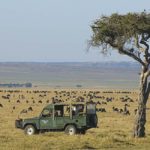Samburu National Reserve
Samburu National Reserve
The Samburu National Reserve is located in the Samburu District, North of the Equator, at an altitude ranging from 800 to 1,230 meters above sea level and it covers an area of about 165-square kilometers, equivalent to 64 sq miles. The reserve is part of a much larger eco system which includes the bordering Buffalo Springs and Shaba National Reserves. Buffalo Springs covers an area of approximately 131sq km and Shaba covers an area of approximately 239sq km.
CLIMATE
Samburu is characterized by a desert and semi-desert region with a dry and warm climate; the Southern border of the reserve is demarcated by the Ewaso Nyiro River, that is the only permanent source of water in this protected area, even during the dry season; from this river depends the survival of all the animals in the reserve.
RAIN
The two major rainfall seasons typical to Kenya also loosely apply to Samburu, with the months from April to May and September to November seeing brief rainy spells nonetheless accompanied by hours of sunshine.
SAMBURU SPECIAL FIVE
Though the reserve is famously known for its Though the reserve is famously known for its special five ( Gravy’s zebra, reticulated giraffe, Beisa Oryx, Somali ostrich and gerenuk ), there are also many other species of animals, mammals, birds and reptiles: lions, leopards, cheetahs, wild dogs, several species of antelopes, gazelles, warthogs, jackals, giraffes, hippos, crocodiles and over 450 species of birds, but especially a large number of elephants; it is estimated that more than 900 specimens live here and it is very common to spot them as they descend to the river to drink and cool off
The Samburu people are one of East Africa’s famous nomadic tribes
The Samburu people are the indigenous nomadic tribe, who live in an arid zone in North-Central Kenya. They are one of the most famous and interesting tribes in Kenya and still retain many of their traditions as they live largely unaffected by modern day civilization. The Samburu have their unique nomadic culture and way of life not to mention their traditonal dress of red or brightly colored ”shukas” or body drapes.
Planning a Safari to Samburu
Delight rose safaris will help you to plan your safari to Samburu according to your budget we have mid-range and luxury
Attractions
Buffalo Springs
Unique flora and fauna
Game drives in the Samburu/Shaba/Buffalo Springs reserves
The endangered Gravy’s zebra
The Ewaso Ngiro River
The Samburu community
Village visit
Camel trekking
ACCOMMODATION
Some of the accommodations we have in Samburu are:
Samburu lodge
Ashnil Samburu
Saruni Samburu lodge
Samburu sopa lodge
Samburu simba lodge
How to get to Samburu National Reserve
By road: we have road packages that will take you to Samburu national reserve It can be reached through Nairobi-Isiolo-Marsabit road and Maralal-Wamba-Isolo road.
VEHICLES
There are two basic types of vehicles commonly used for road Safaris in Kenya and generally in East Africa. These are the Safari Tour Minibuses (Tour Vans) and the 4×4 Safari Jeeps, typically Toyota Land cruiser. All types of vehicles have built in, pop-up roof for game viewing. Driver opens once on a game drive in the park or reserve, UHF Radio Calls and Cooler Boxes.
The Tour Vans cost much less than the four-wheel drive Safari Jeeps. Should be noted that there are some tour vans which also come with 4×4 capability, albeit with the lack of ground clearance or off road ability that comes with a Land cruiser. Both types of vehicles typically seat a maximum of 7 passengers with 6 being ideal and 8 passenger
By air: We have flying packages that will take you to Samburu national reserve
delight rose safaris to samburu and other parts of kenya
4 days samburu and lake Nakuru safari
Book a safari to samburu




















Kenya big five safariAugust 28, 2023
[…] Samburu-Buffalo Springs-Shaba, […]